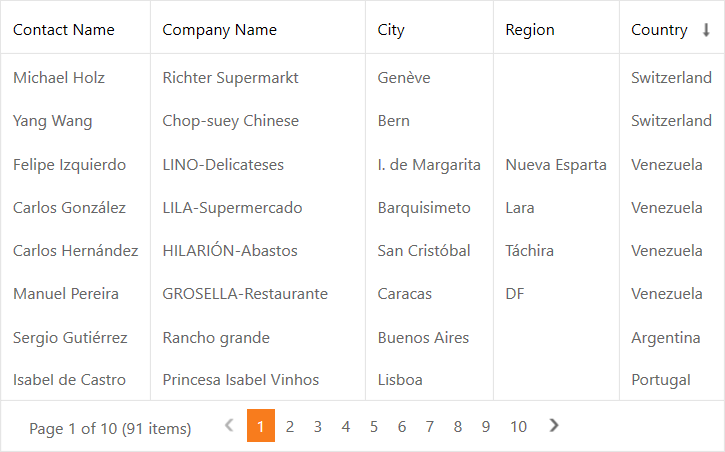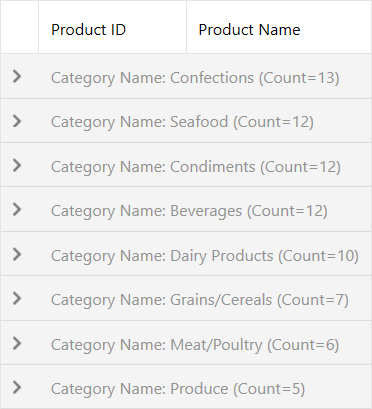Sort Data
- 4 minutes to read
ASPxGridView allows you to sort column data.
To allow end users to sort column data, set the AllowSort property to true in the following objects:
ASPxGridBehaviorSettings.AllowSort - for all columns;
GridDataColumnSettings.AllowSort - for an individual column. If this property value is Default, the column’s behavior depends on the ASPxGridBehaviorSettings.AllowSort property value.
<dx:ASPxGridView ID="grid"> <SettingsBehavior AllowSort="true"/> <Columns> <dx:GridViewDataColumn FieldName="ContactName" SortIndex="2" SortOrder="Ascending" > <Settings AllowSort="false" SortMode="DisplayText" /> </dx:GridViewDataColumn> ... </Columns> </dx:ASPxGridView>
The integrated data sorting algorithm only works on types that implement the IComparable interface. If a column’s data type does not support this interface, or you wish to change the default sort order, apply a custom sort.
Sort in UI
Click an unsorted column’s header to sort the column and clear the sort order for other columns. The sort glyph indicates the column’s current sort order. To change the sort order, click the header again.
To sort data in multiple columns, hold the SHIFT key and click the required column headers. To clear the sort order for an individual column, press the CTRL key and click the column header.
The image below illustrates sorted columns in the grid:
- the Country column’s data is sorted in descending order;
- the City column’s data is sorted in ascending order.

Online Demo: Sorting Data
Sort in Code
Sort a Column
Use any of the following API members to sort a column:
Specify a column’s GridViewDataColumn.SortOrder property.
Call a column’s GridViewDataColumn.SortAscending or GridViewDataColumn.SortDescending method.
Call the server-side ASPxGridView.SortBy method.
Call the client-side ASPxClientGridView.SortBy method.
function ProcessSorting(s, e, grid) { grid.SortBy(e.column.name); ... }
Clear Sorting
Use any of the following API members to clear the sort order:
Set a column’s GridViewDataColumn.SortOrder property to None.
Call a column’s GridViewDataColumn.UnSort method.
Set a column’s GridViewDataColumn.SortIndex property to -1.
Call the control’s ASPxGridBase.ClearSort method.
Related API
| API member | Type | Description |
|---|---|---|
| ASPxClientGridView.ColumnSorting | Event | Enables you to prevent columns from being sorted. |
| ASPxGridView.BeforeColumnSortingGrouping | Event | Enables you to to manage a column before it is sorted or grouped. |
| ASPxGridView.CustomColumnSort | Event | Enables you to use custom sorting algorithms. |
| ASPxGridView.IsAllowSort | Method | Indicates whether data sorting is allowed. |
| ASPxGridView.GetSortedColumns | Method | Returns a collection of sorted columns. |
| ASPxGridBase.SortCount | Property | Gets the number of sorted columns. |
| GridViewDataColumn.SortIndex | Property | Gets or sets a column’s position among sorted columns. |
| GridViewDataColumn.SortOrder | Property | Gets or sets the column’s sort order. |
Custom Sorting
- Set the GridDataColumnSettings.SortMode property to Custom.
- Handle the ASPxGridView.CustomColumnSort event to apply a custom sorting algorithm to the column.
The example below sorts the Country column by character length in descending order.
<dx:ASPxGridView ID="ASPxGridView1" runat="server" OnCustomColumnSort="grid_CustomColumnSort">
<Columns>
<dx:GridViewDataColumn FieldName="Country" SortOrder="Descending">
<Settings SortMode="Custom" />
</dx:GridViewDataColumn>
...
</Columns>
...
</dx:ASPxGridView>
protected void grid_CustomColumnSort
(object sender, DevExpress.Web.CustomColumnSortEventArgs e) {
if (e.Column.FieldName == "Country") {
e.Handled = true;
string s1 = e.Value1.ToString(), s2 = e.Value2.ToString();
if (s1.Length > s2.Length)
e.Result = 1;
else
if (s1.Length == s2.Length)
e.Result = Comparer.Default.Compare(s1, s2);
else
e.Result = -1;
}
}
Result:

Sort Groups by Summary Values
To sort groups by their summary values, create an instance of the ASPxGroupSummarySortInfo object, customize its settings and add this object to the ASPxGridView.GroupSummarySortInfo collection. Remove this object from the collection to cancel sorting.
The example below sorts rows in groups by their summary values in descending order.
using DevExpress.Data;
using DevExpress.Web;
protected void Page_Load(object sender, EventArgs e)
{
grid.GroupSummarySortInfo.Clear();
ASPxGroupSummarySortInfo sortInfo = new ASPxGroupSummarySortInfo();
sortInfo.SortOrder = ColumnSortOrder.Descending;
sortInfo.SummaryItem = grid.GroupSummary["ProductName", SummaryItemType.Count];
sortInfo.GroupColumn = "CategoryName";
grid.GroupSummarySortInfo.AddRange(sortInfo);
}
<dx:ASPxGridView ID="grid" runat="server" AutoGenerateColumns="False" DataSourceID="SqlDataSource1">
<Columns>
<dx:GridViewDataTextColumn FieldName="ProductID" VisibleIndex="0"/>
<dx:GridViewDataTextColumn FieldName="CategoryName" GroupIndex="0" VisibleIndex="1"/>
<dx:GridViewDataTextColumn FieldName="ProductName" VisibleIndex="2"/>
</Columns>
<GroupSummary>
<dx:ASPxSummaryItem FieldName="ProductName" SummaryType="Count" />
</GroupSummary>
</dx:ASPxGridView>
Result:

Online Demo: Sort by Summaries